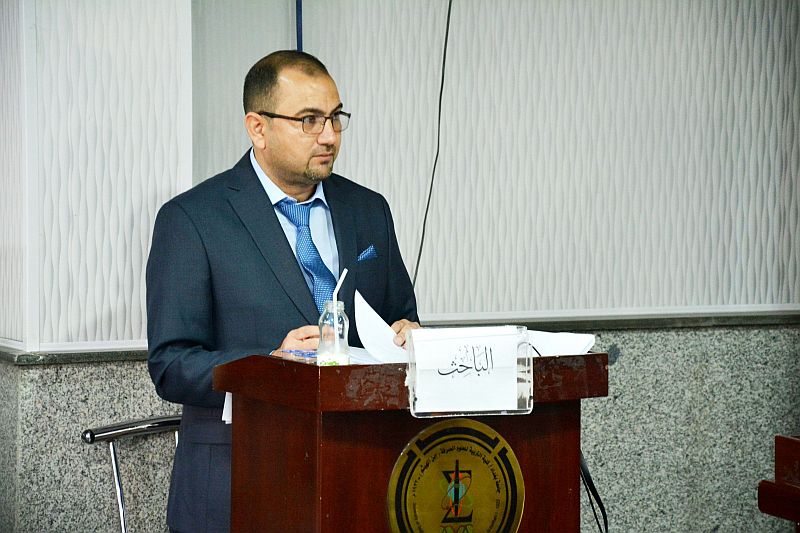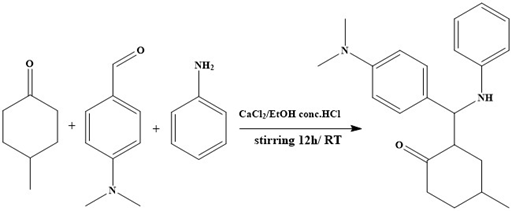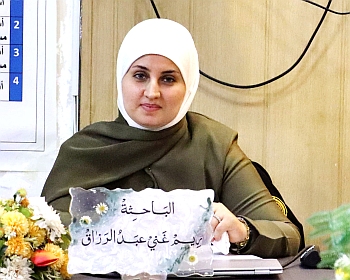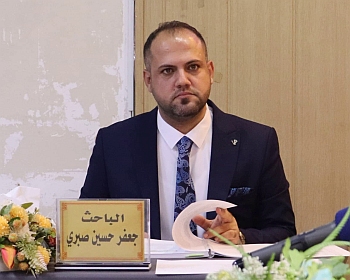ناقش قسم الكيمياء في كلية التربية للعلوم الصرفة (ابن الهيثم) رسالة الماجستير الموسومة ( معقدات فلزية جديدة مشتقة من ليكاندات مانخ; تحضير و تشخيص طيفي مع التقييم البيولوجي ) للطالب ( عمار حسن عبد الهادي ) التي انجها تحت اشراف التدريسي في القسم ( أ.د. محمد جابر ابراهيم الجبوري) ، ونوقشت من قبل اعضاء لجنة المناقشة المدرجة اسمائهم فيما ياتي:
-
أ.د. حسن أحمد حسن (رئيسا)
-
أ.م.د. عيد صالح محمد (عضوا)
-
أ.م.د. ورود علي جعفر (عضوا)
-
أ.د. محمد جابر ابراهيم الجبوري (عضوا ومشرفا)
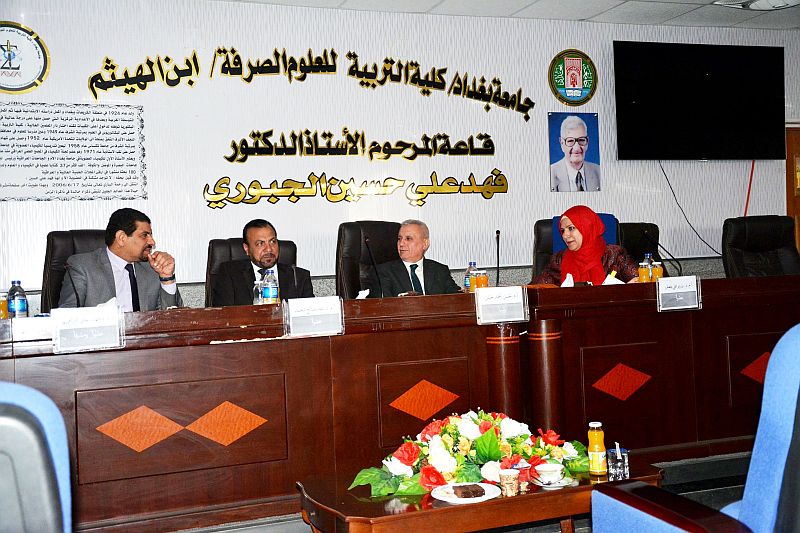
ويهدف البحث الى تحضير :
-
ليكاند ثنائي السن من قواعد مانخ وتم تسميته :
(2R)-2-((R)-(4(dimethylamino)phenyl)(phenylamino)methyl) 4methylcyclohexan-1-one (HL1)
من مزج ثلاث مركبات عضوية (بارا-مثيل سايكلوهكسانون , الأنلين , بارا ثنائي مثيل امينو بنزلديهايد )
-
تحضير قاعدة شيف لليكاند ثلاثي السن جديد ثايوسيمي كاربازون وتم تسميته :
(E)-2-((2S)-2-((S)-(4(dimethylamino)phenyl) (phenylamino)methyl))-4-methylcyclohexylidene)hydrazine-1-carbothioamide (H2L2)
من مزج الليكاند الاول مع الثايوسيمي كاربازايد
-
تحضير سلسلة معقدات لكلا الليكاندين مع ايوانات Mn(II), Co(II), Ni(II), Cu(II), Zn(II) Cd(II),
-
دراسة التراكيب المقترحة والاشكال الفراغية لليكاندات ومعقداتها المحضرة
-
استكشاف النشاط الميكروبيولوجي لكلا الليكاندين ومعقداتها ضد سلالات G + و G- من البكتيريا ونوعين من الفطريات.
تشمل هذه الدراسة تحضير والتشخيص الهيكلي والنشاط البيولوجي لنوعين من الليكاندات مع معقداتها الفلزية. الليكاند الاول يسمى :
(2R)-2-((R)-(4(dimethylamino)phenyl)(phenylamino)methyl)-4-methyl cyclohexan-1-one (HL1)
و قد تم تحضيره من خلال التفاعل الاحادي مشتق من تفاعل مانخ باستخدام كلوريد الكالسيوم كمحفز. اجراء التفاعل تم باستخدام الكحول الاثيلي كوسط للتفاعل ومن خلال مزج ثلاث مكونات هي : بارا-ثنائي-مثيل-امينو بنزلديهايد , الانلين و بارا-مثيل سايكلوهكسانون بنسبة مولية مقدارها 1:1:1, على التوالي , تم تحريك المزيج لمدة 12 ساعة عند درجة حرارة الغرفة. تم الحصول على الناتج المطلوب كمادة صلبة ثم ترشيحها وغسلها بالماء المقطرواعادة بلورتها وتجفيفها .راجع المخطط( أ ).
والليكاند الثاني : (E)-2-((2S)-2-((S)-(4(dimethylamino)phenyl) (phenylamino)methyl)-4-methyl cyclohexylidene)hydrazine-1carbothioamide (H2L2).
تم تاكيد تكوين الليكاند (H2L2) من تفاعل التكثيف لمجموعة الكيتون مع مركب الثايوسيمي كاربازايد وبالتالي تم استخدام HL1 كمادة اولية توفر مجموعة الكاربونيل والتي تتفاعل مع امين الجزء الهيدرازيني من الثايوسيمي كاربازايد. تم تحضير(H2L2) من اضافة ما يعادل مكافى واحد من محلول الايثانولي من الثايوسيمي كاربازايد الى نسبة مكافى لليكاند HL1 لأعطاء (H2L2) بكمية معتدلة. تم التفاعل لمدة 5 ساعات بواسطة التصعيد العكسي وتم ترشيح الناتج الصلب وغسله باستخدام الايثانول والايثر, انظر المخطط (ب).
المخطط (أ) : الطريقة العامة لتحضيرالليكاند الاول HL1.
 المخطط (ب) : الطريقة العامة لتحضير الليكاند الثاني H2L2.
المخطط (ب) : الطريقة العامة لتحضير الليكاند الثاني H2L2.
تم استخدام كلا الليكاندين المحضرين لتحضير مجموعة من المعقدات الفلزية مع ايونات :
Mn(II), Co(II), Ni(II), Cu(II), Zn(II) and Cd(II)
في نسبة 2:1 (فلز:ليكاند) باستخدام الايثانول او DMF كمذيب. تم تحريك المزيج لمدة 24 ساعة بدرجة حرارة الغرفة. تم السماح للمحلول بالتبخر ببطء عند درجة حرارة الغرفة , وتم تكوين مسحوق صلب والذي تم ترشيحه وغسله باستخدام الكلوروفورم والايثر, انظر للمخطط ج. اعطى الليكاند الاول HL1 معقدات فلزية مونمرية للصيغة العامة :
[Mn(HL1)2(Cl)2], [M(HL1)2(Cl)2](H2O) (where M= Co(II), Ni(II), Cu(II) , [Zn(HL1)](H2O) Cl2 and [Cd(HL1)] Cl2
أعطى (H2L2) المعقدات البوليمرية عند تفاعله مع الايونات الفلزية المذكورة آنفاَ ذات صيغة عامة:
{[M(HL2)]Cl2}n (where M= Mn(II), Co(II), Ni(II), Cu(II), Zn(II), Cd(II))
انظر للمخطط ( د). تم تأكيد التركيب الكيميائي للليكاندات المحضرة ومعقداتها الفلزية باستخدام :مطيافية الاشعة تحت الحمراء, والأطياف الألكترونية , والرنين النووي المغناطيسي (1H,13C) ومطيافية الكتلة والتحليل الدقيق للعناصر و فحص الحساسية المغناطيسية , التوصيلية المولارية و ودرجة الانصهار.
 المخطط (ج) : الطريقة العامة لتحضير معقدات اللكند الاول HL1.
المخطط (ج) : الطريقة العامة لتحضير معقدات اللكند الاول HL1.
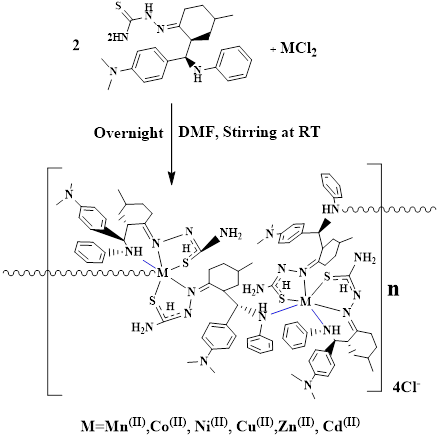 المخطط (د) : الطريقة العامة لتحضير معقدات الليكاند الثاني H2L2.
المخطط (د) : الطريقة العامة لتحضير معقدات الليكاند الثاني H2L2.
وبناءً على البيانات التحليلية والطيفية اقترحت التراكيب الاتية:
1- كانت معقدات HL1 مع ايونات Mn(ӀӀ), Co(ӀӀ), Ni(ӀӀ) and Cu(ӀӀ) ذات تركيب اوكتاهيدرا المشوه.
2- ترتيب رباعية السطوح مع معقدات Zn(II) Cd(II).
3- اشكال ثمانية السطوح مشوهه حول الايون الفلزي لـ H2L2 مع ايونات Mn(ӀӀ), Co(ӀӀ), Ni(ӀӀ), Cu(ӀӀ), Zn(II) , Cd(II).
تم تقييم المركبات المحضرة (الليكاندين ومعقداتها الفلزية) لنشاطها المايكروبايولوجي تجاه مجموعة من البكتريا والفطريات. وتشمل الأنواع البكتيرية نوعين من السلالات : بكتريا ايجابية لصبغة غرام : (Staphylococcus aureus, Bacillus subtilis)
وسالبة لصبغة غرام: (Escherichia coli , Proteus spp)
تصيب البكتريا المستخدمة في هذا العمل الجهاز البولي والتنفسي للبشر وتحسب بعضها كنوع من البكتريا المميتة والتي ممكن ان تنشط في غرفة العمليات الجراحية.
بشكل عام ، تشير الاستنتاجات المتعلقة بالنشاط المضاد للبكتيريا إلى أن بيانات الاستنبات أظهرت معقدات HL1 نشاطًا مضادًا للميكروبات ضد معظم أنواع البكتيريا ، مقارنةً الليكاند الحر. أظهرت معقدات H2L2 نشاطًا أكبر ضد بعض أنواع السلالات البكتيرية ، مقارنةً باليكاند الحر. أظهر HL1 و H2L2 تثبيط تجاه نوع واحد من البكتيريا Proteus spp و Staphylococcus aureus على التوالي. يبدو ان معقدات HL1 لديها نشاط مضاد للبكتريا اعلى بالمقارنة مع معقدات H2L2. اضافة الى ذلك غطت الدراسة النشاط المضاد للفطريات لنوعين منها: النوع الاول هو Candida albicans ويصيب الجهاز الهضمي والفم في 40-60% من البالغين الاصحاء. النوع الثاني هو Trichophyton rubrum ويسبب التهاب جريبات الشعر في الذقن و فروة الرأس والمسؤول عن اصابة القدم الرياضي. اشارت البيانات الى مقاومة فطريات Trichophyton rubrum في كلا الليكاندين . يظهر H2L2 نشاطا مضاد ضد نوع Candida albicansمقارنة بـ HL1. أشارت معقدات HL1 الفلزية إلى نشاط أعلى تجاه الفطريات التي تم فحصها ، مقارنةً بالليكاندات الحرة المشتقة منها. أظهرت البيانات التي تم جمعها أن H2L2 يعتبر أكثر نشاطًا ضد Candida albicans ، مقارنة مع معقداته الفلزية.
وخلص الطالب الى التوصيات الاتية :
-
تحضير ليكاندات مانخ وليكاندات الثايوسيميكاربازون جديدة من مجموعة متنوعة من المواد الاولية وبدائل مختلفة
-
تحضير معقدات فلزية جديدة من الليكاندات المذكورة اعلاه باستخدام ايونات فلزية من السلسلة الانتقالية الثانية والثالثة
-
العمل على اعادة بلورة وتكوين بلورة مناسبة لليكاندات المذكورة ومعقداتها من اجل تحديد اشكالها من خلال X-ray single crystal
-
فحص المركبات المحضرة ضد كائنات دقيقة اخرى
-
التحقيق في انشطار الحمض النووي والنشاط المضاد للسرطان للمركبات المحضرة
New metal complexes derived from Mannich ligands ; synthesis, spectral investigation and biological evaluation
Ammar Hassan Abdulhadi Mahdi Al-Qazzaz
Prof. Dr. Mohamad J. Al-Jeboori \ Department of Chemistry
Aim of the work
-
Synthesis of new bidentate Mannich-base ligand namely; (2R)-2-((R)-(4(dimethylamino)phenyl)(phenylamino)methyl)-4methylcyclohexan-1-one (HL1) from mixing of a three organic component (p-methylecyclohexanone, phenylamine, p-dimethylaminobenzaldehyde).
-
Synthesis of new tridentate thiosemicarbazone Schiff-base ligand namely; (E)-2-((2S)-2-((S)-(4(dimethylamino)phenyl) (phenylamino)methyl))-4-methylcyclohexylidene)hydrazine-1-carbothioamide (H2L2) by mixing HL1 with thiosemicarbazide.
-
Synthesis of a range of metal complexes from the reaction of both ligands with Mn(II), Co(II), Ni(II), Cu(II), Zn(II) and Cd(II), ions.
-
Studying the possible structures and the stereochemistry of ligands and complexes.
-
Exploring the microbiological activity of ligands and their complexes against G+ and G– strains of bacteria and two types of fungi.
Abstract :
This study includes the formation, structural characterisation and biological activity of two ligands and their metal complexes. The preparation of ligand (2R)-2-((R)-(4(dimethylamino)phenyl) (phenylamino)methyl)-4-methyl cyclohexan-1-one (HL1) was accomplished through a one-pot reaction derived from Mannich approach in which CaCl2 was used as a catalyst. The reaction was achieved in EtOH by mixing three components; p-dimethylaminobenzaldehyde, aniline and p-methylcyclohexanone with a 1:1:1 mole ratio. The resulting mixture was stirred for 12 h at room temperature. The title product was obtained as a solid material that filtered off, washed with distilled water, recrystallized from EtOH and then dried under vacuum, see Scheme(I). The synthesis of second ligand H2L2 was performed by the condensation reaction of the ketone group of HL1 with the amine group of the thiosemicarbazide moiety. In the formation of H2L2 ((E)-2-((2S)-2-((S)-(4(dimethylamino)phenyl)(phenylamino)methyl)-4-methyl cyclohexylidene) hydrazine-1carbothioamide) (H2L2). The fabrication of H2L2 was derived from the addition of a 1 equivalent of an ethanolic solution of thiosemicarbazide to an equivalent mole ratio of HL1 at reflux for 5 h that resulted in the isolation of H2L2 in a moderate yield. The solid product was filtered off then washed with ethanol and ether, Scheme (I).
Scheme (I): General synthetic steps of HL1 and H2L2.
The prepared ligands were used to synthesize a range of complexes with Mn(II), Co(II), Ni(II), Cu(II), Zn(II) and Cd(II) ions in a 1:2 (M:L) mole ratio using ethanol or DMF as a solvent. The resulting mixture was stirred for 24 h at room temperature. The solution was allowed to evaporate slowly at RT and a coloured solid powder was formed, which filtered off, washed with chloroform and diethylether. The HL1 gave monomeric complexes with the title metal ion of the general formula [Mn(HL1)2(Cl)2], [M(HL1)2(Cl)2].(H2O) (where M= Co(II), Ni(II), Cu(II) , [Zn(HL1)]Cl2.(H2O) and [Cd(HL1)]Cl2, see Scheme (II). The H2L2 gave polymeric complexes upon reaction with the title metal ion of the general formula {[M(HL2)2]Cl2}n, see Scheme (III). The chemical structure of the entity ligands and their metal complexes were confirmed using; FT-IR, electronic spectra, 1H- and 13C-NMR spectra, electrospray mass spectroscopy, elemental analysis, magnetic susceptibility, molar conductivity and melting point.
Scheme (II): General synthetic route of HL1 complexes.
Scheme (III): General synthetic route of H2L2 complexes.
Based on the analytical and spectroscopic data, the following structures are suggested:
-
HL1 complexes with Mn(ӀӀ), Co(ӀӀ), Ni(ӀӀ) and Cu(ӀӀ) ions indicated the formation of six coordinate complexes with distorted octahedral geometry around metal centre.
-
A tetrahedral arrangement was suggested with Zn(II) and Cd(II)
-
H2L2 complexes with Mn(ӀӀ), Co(ӀӀ), Ni(ӀӀ), Cu(ӀӀ), Zn(II) and Cd(II) ions revealed the isolation of distorted octahedral geometry about metal core.
The prepared compounds (ligands and their metal complexes) have evaluated for their microbiological activity toward a range of bacteria and fungi microorganism. The bacterial species include two type of strains : G-positive (Staphylococcus aureus, Bacillus subtilis) and G-negative (Escherichia coli , Proteus spp). The examined bacteria in this work have the ability to infect the urinary and respiratory tract of humans and account as the nasty and deadly type of bacteria that found in the surgery operation room. Generally, anti-bacterial activity data show that the complexes of HL1 exhibited antimicrobial activity against most bacterial species, compared with the free ligand. The complexes of H2L2 exhibited enhanced activity against some types of the bacterial strains, compared with the free ligand. HL1 and H2L2 showed inhibition activity towards one kind of bacteria; Proteus spp and Staphylococcus aureus, respectively. The HL1 complexes appeared to have the highest anti-bacterial activity, compared with the H2L2 complexes. More, the activity against fungal species covered two types of fungi. The first species Candida albicans is detected in the gastrointestinal tract and mouth in 40–60% of healthy adults. The second species Trichophyton rubrum has the ability to infect the feet scalp and it is responsible for athlete’s foot infection. The obtained data indicated the resistance of Trichophyton rubrum against both ligands. More, H2L2 shows activity against Candida albicans compared with HL1. The HL1 metal complexes indicated higher activity towards the examined fungi, compared with the free ligand. Based on data, H2L2 indicated to be more active against Candida albicans, compared with its complexes.
Prospective studies
-
Formation of new Mannich-base and thiosemicarbazone ligands with a variety of starting materials and different substituents.
-
Formation of new metal complexes with the above ligands using transition metal ions including that from the second and/or third series of transition ions.
-
Working on the recrystallization of the ligands and their metal complexes in order to isolated crystals that suitable for X-ray single crystal structure.
-
Screening the prepared compounds against other microorganism.
-
Investigating the DNA cleavage and anti-cancer activity of the prepared compounds.


